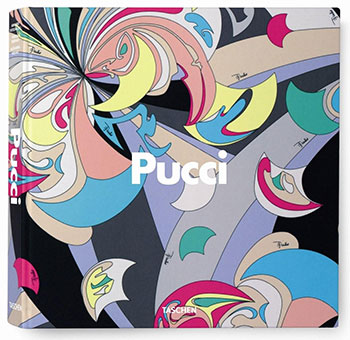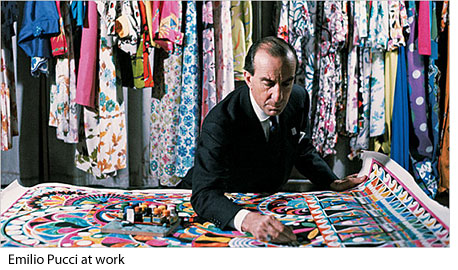“Emilio Pucci”: A Book Review
The secret was in the cut and the combination of colours, according to the prince of prints
Sue Smith
 DARK-eyed, good-looking Marchese Emilio Pucci (1914-1992), Italy’s aristocratic dress designer, known as “the prince of prints” and “the man who put women in pants”, always believed a good cut was the secret of casual style – along with an unerring eye for colour combinations.
DARK-eyed, good-looking Marchese Emilio Pucci (1914-1992), Italy’s aristocratic dress designer, known as “the prince of prints” and “the man who put women in pants”, always believed a good cut was the secret of casual style – along with an unerring eye for colour combinations.
Now a stunning new coffee table book (Emilio Pucci by Vanessa Friedman (Taschen) ), presenting hundreds of photographs, drawings and candid shots from the archive of the Emilio Pucci Foundation, reveals the vision of the Italian designer whose label grew from one tiny boutique on the isle of Capri to an international brand beloved by wealthy sophisticates, heiresses and movie stars.
Pucci, who began dabbling in fashion as an amateur after 14 years as an officer pilot in the Italian Air Force, created a sensation in 1948 with his slim, tapered trousers which he admitted came about largely by accident.
“I was skiing in Austria with a party with an Englishwoman who was wearing slacks,” Pucci recounted to a journalist in 1954.
“The slacks looked ghastly ─they were the old baggy-legged type. Luckily there was a slight mishap and they got torn. I agreed to design her a more becoming pair.
“When I got down to tin tacks, I found the only way to give a woman wearing trousers a smart, clean-cut line and a casual look, was to taper the legs.”
 Pucci’s idea for slim, tapered pants spread around the world like wildfire and, by 1949, American buyers were clamouring so insistently that Pucci left the Air Force and set up as a full-time designer, making Capri the base for his first boutique. His workrooms were in the vast 1000-year-old Palazzo Pucci in Florence – which Emilio Pucci inherited on his father’s death. Although virtually a shambles, the palace contained fabulous treasures (especially paintings by Botticelli, Raphael and Leonardo da Vinci) and Pucci in his early career poured every penny he made into restoring it.
Pucci’s idea for slim, tapered pants spread around the world like wildfire and, by 1949, American buyers were clamouring so insistently that Pucci left the Air Force and set up as a full-time designer, making Capri the base for his first boutique. His workrooms were in the vast 1000-year-old Palazzo Pucci in Florence – which Emilio Pucci inherited on his father’s death. Although virtually a shambles, the palace contained fabulous treasures (especially paintings by Botticelli, Raphael and Leonardo da Vinci) and Pucci in his early career poured every penny he made into restoring it.
By the 1950s, heiress Doris Duke and film stars such as Gina Lollobrigida, Ava Gardner and Marilyn Monroe were among his clients and Pucci was flying monthly to the US with ideas for styles and colour schemes nobody had ever though of before, such as violet and green offset with touches of black and white.
Pucci himself, when not in conservative tailored suits, sometimes wore elegantly casual shirts, open at the neck. His loose overblouses for women featuring colourful prints, often in five or six colours, became some of his signature designs.
“For clothes to look truly casual,” he once said,”they must be exquisitely cut and extremely well-fitting. There’s a world of difference between ‘casual’ and ‘untidy’.”
Known as the “prince of prints”, Pucci had an unerring flair for colour and was also extremely efficient: he designed intricate colour patterns using a special colour “shorthand”.
“I have 10 bottles of coloured ink,” Pucci explained in 1964, “and each one is numbered. I know the colours by heart.”
Working initially on a black and white design for a complex print, he would point to spaces as an assistant wrote down the appropriate numbers. In less than a minute, the colour scheme was finished and he would turn to another design sheet. Assistants would later fill in the design in colours according to the numbers and the design would then go straight to the printers. Pucci only ever saw the finished design when it returned from the printers.
Pucci -- a genius of the casual perhaps, but always artful.
